The bi-annual SIAM Conference on Applications of Dynamical Systems,
better known as the SIAM Snowbird meeting, was held May 27-31 this
year. This meeting always takes place round this time of the year,
when the ski-season just finishes, snow is still on the mountain
slopes, and the temperature is still bearable high up in the mountains
near Salt Lake City, Utah. This year the meeting was organized by
Tasso Kaper (Boston University, USA) and Mary Pugh (University of
Toronto, Canada). Personally, I enjoy the Snowbird meetings
very much, because it is a gathering place for all dynamical systems
people around the world. The meeting is very intense, with lots of
parallel sessions and spare time in between is spent on scientific
discussions. With only few restaurants nearby (Salt Lake City is a
45-minute drive downhill), one is bound to bump into each other,
whether you like it or not. There is no escaping!
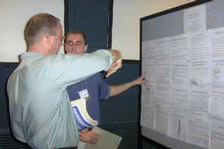 |
| Contrary to popular belief, Tasso Kaper
did not manage to avoid the photographer! |
|
 |
| Mary Pugh discussing with Charles
Doering and Yannis Kevrekidis |
|
| Participation was hampered a little due
to the SARS virus, since many people from Asian countries could not
travel, but still around 670 people attended this year. The meeting
started with a barbeque on the Monday before the talks. Another
organisational change was that the plenary sessions were all scheduled
before and after lunch. The plenary sessions were on a wide range of
topics. Specific highlights were the talks by Detlef Lohse (University
of Twente, The Netherlands) on Sonoluminescence: Illuminating
Bubbles, Garrett Odell (University of Washington, USA) on What
is the Design Trick by which Natural Selection Evolved Such
Astonishingly Robust Genetic Networks? and the presentation of Leo
Kadanoff (University of Chicago, USA) on Computer Simulation of
Dynamical Systems: The Good, the Bad, and the Awful. |
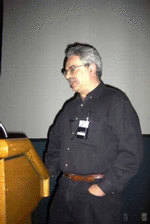 |
| The Crawford prize was awarded to
Yannis Kevrekidis |
|
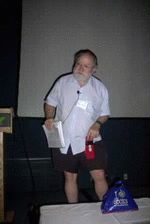 |
| Jim Yorke checks the quality of the red
socks |
|
One very good aspect
of the Snowbird meetings is the poster session. This year it was again
very successful. The posters are of exceptional quality, with many
presenters taking the effort to produce an A1 size color print-out
(and laminate them!) Five winners were announced the next day and
received a cash prize and the famous red socks from Jim
Yorke.
|
 |
| Good posters, good food, good
company |
|
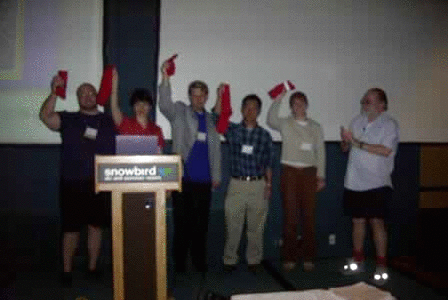 |
| Authors of the best five posters win a cash prize and the
now famous pair of red socks. From left to right: John Burke, Rodica
Curtu, Thilo Gross, Takashi Nishikawa, Claire Postlethwaite, and the
chair of the poster prize committee, Jim Yorke. |
| Poster prize winners and the titles of their
posters |
John Burke
Arizona State University (USA) |
A Canonical Model of
Cascades of Mediating Signaling Molecules in Metabolic Cellular
Circuits |
Rodica Curtu
University of Pittsburgh (USA) |
Pattern Formation in
a Network of Excitatory and Inhibitory Cells with Adaptation |
Thilo Gross
Carl von Ossietzky Universität, Oldenburg, Germany |
Analytical Search for Bifurcation Surfaces in Parameter
Space |
Takashi Nishikawa
Arizona State University (USA) |
Phase Oscillator
Neural Networks with Error-Free Memory Recall |
Claire Postlethwaite
Cambridge University (UK) |
Heteroclinic Networks in
Rotating Convection |
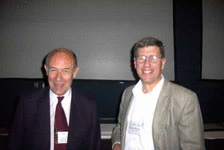 |
| David Ruelle with Eugene Wayne, chair of the selection committee |
|
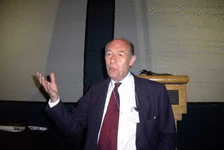 |
| David Ruelle discussing statistical
mechanics |
|
Two prizes are awarded during the Snowbird meeting, namely the
Jürgen Moser Lecture and the J. D. Crawford prize. The
Jürgen Moser lecture was given by David Ruelle (Institut des
Hautes Etudes Scientifiques, France). David McLaughlin (Courant
Institute, USA) introduced this distinguished speaker. David Ruelle is
well known for his research in dynamical systems. In particular for
his work on the notion of strange attractors and chaotic behavior. His
lecture Is there a Natural Dynamics for Systems with Many Degrees
of Freedom? addressed the possibility that large systems, which
can be non-hyperbolic, do conform to and interpretation based on
uniform hyperbolicity behavior and SRB states. The Crawford prize was
awarded to Yannis Kevrekidis from Princeton University for his recent
work on using sophisticated nonlinear dynamics tools on systems that
are not easily modelled as an explicit ODE. In his plenary lecture
Equation-Free Multiscale Computation: Enabling Microscopic
Simulations to Perform System-Level Tasks he explained how this
works.
As usual, after a lengthy debate during the business meeting of the
SIAM Dynamical Systems activity group, it was decided that the next
Snowbird meeting (oh, I mean the SIAM Conference on Applications of
Dynamical Systems!) will be held again in Snowbird, Utah in 2005. See
you then!
All photographs by Bernd Krauskopf or Hinke Osinga.
|